Ask Ethan: Can Black Holes Ever Spit Anything Back Out?

A black hole’s event horizon is thought of as the point of no return. But perhaps there are ways back out, after all.
Black holes just might be the most extreme objects that exist in the entire Universe. While every quantum of matter or energy is affected by the gravitational force, there are other forces capable of overcoming gravity everywhere you go, except inside a black hole. The most important feature of a black hole is the existence of an event horizon; no other class of object has them. Although black holes have this region where gravity is so strong that nothing can escape, not even if they move at the speed of light, perhaps there are loopholes to the inescapability of a black hole’s gravity, after all. That’s the subject of this week’s question, which comes from Noah, who asks,
Do black holes ever spit things out at any time?
And if they do, do they ever spit out light?
The answer must be yes. After all, the most surprising thing about black holes — both predicted theoretically and observed directly — is that they aren’t black at all.
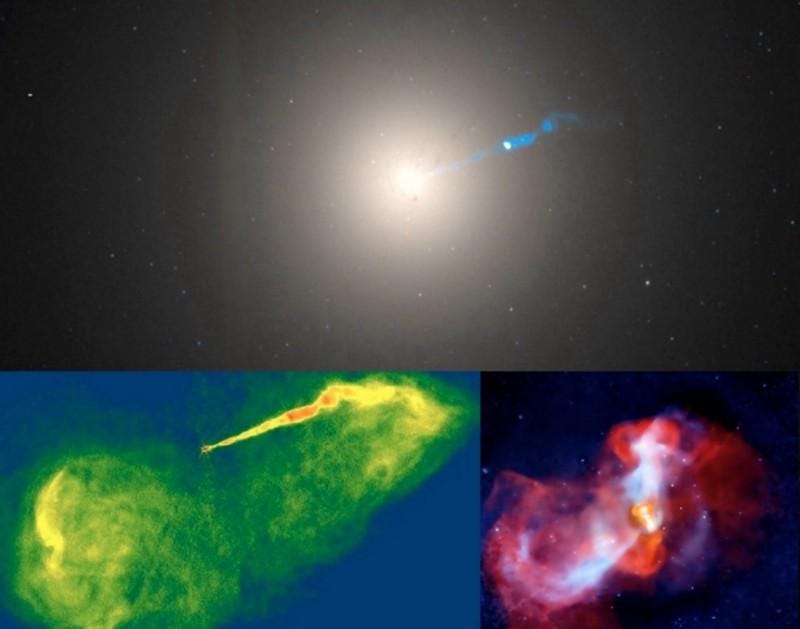
If black holes were entirely dark, there would be no way to detect them at all, save for the gravitational influence that they might have on the other objects around them. If we had a black hole and a star in orbit around one another, we’d be able to infer the existence (and the mass) of the black hole simply by watching how the star appeared to move over time.
As it wobbled back-and-forth in its orbit, we could determine the parameters of the other object present, including the mass, orbital separation distance, and if our measurements were good enough, even its angle-of-inclination relative to our line of sight. Based on the light that comes from it, we could know whether it was a star, a white dwarf, a neutron star, or — if there were no light at all — even a black hole.
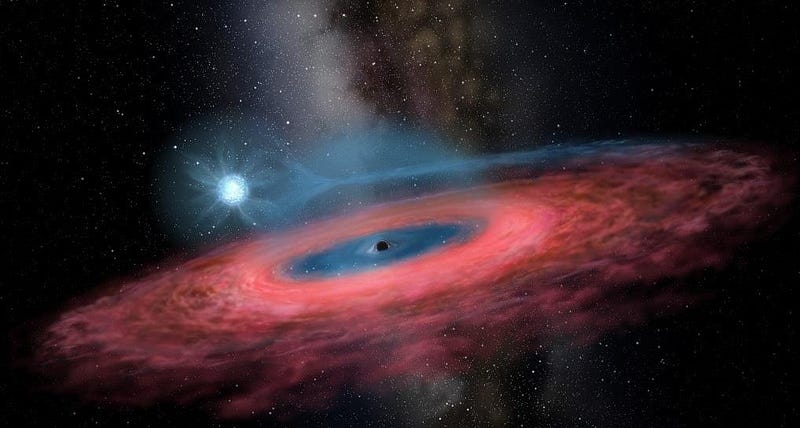
But in our practical, realistic Universe, the black holes that orbit other stars are actually detectable through radiation.
“Hang on,” you might object, “if black holes are regions of space from which nothing can escape, not even light, then how are we seeing radiation coming from the black hole itself?”
That’s a valid point, but what you have to understand is that the space outside of a black hole’s event horizon doesn’t have to be devoid of matter. In fact, if there’s another star nearby, that star can serve as a rich source of matter, capable of being siphoned onto the black hole, particularly if the nearby star is giant and diffuse. This sort of system, in particular, creates what we observe as an X-ray binary, and it’s how the first black hole we ever found was detected.

Matter, if you break it down to a subatomic level, is made of charged particles. Put this matter in the vicinity of a black hole, and it will:
- move rapidly,
- collide with other matter particles,
- heat up,
- create electric currents and magnetic fields,
- accelerate,
- and emit radiation.
Some of the matter will lose momentum and fall into the black hole, passing through the event horizon and adding to the black hole’s mass. However, the majority of the matter won’t fall in at all, but rather will get funneled into an accretion disk (or more generally, an accretion flow) that experiences the electromagnetic forces from all the accelerating matter. As a result, we see two jets that get expelled in opposite directions emanating from black holes.
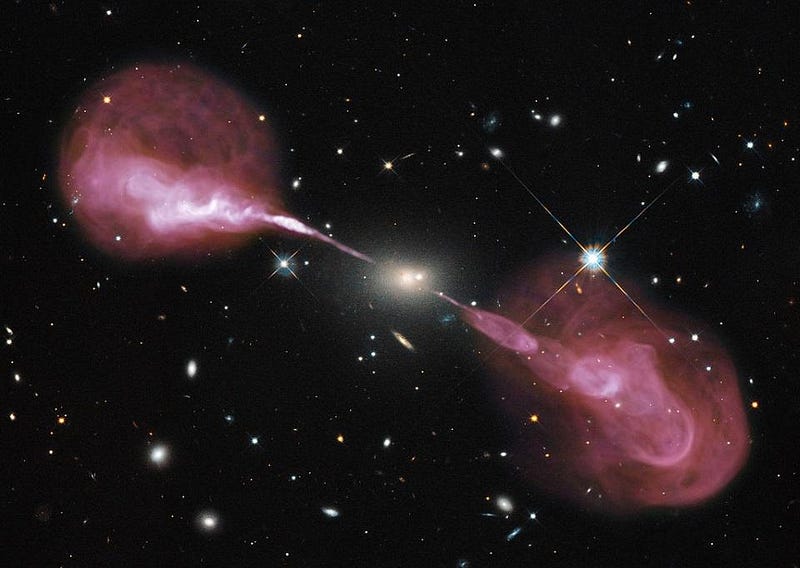
These relativistic jets are made of particles and emit enormous amounts of light from their dynamical interactions with the particles in the interstellar medium. In fact, the same physics is at play in the supermassive black holes found at the centers of galaxies: matter that falls in towards the black hole largely gets ripped apart, funneled into accretion flows, accelerated, and ejected in jet-like structures.
If you were a real particle outside of the black hole’s event horizon, but were gravitationally bound to the black hole, you’d be compelled to move in an elliptical orbit around it. At your point of closest approach — the periapsis of your orbit — you’ll be moving at your fastest speed, which gives you the greatest likelihood of interacting with other particles. If they’re present, you’ll experience inelastic collisions, friction, electromagnetic forces, etc. In other words, all the forces that cause charged particles to emit radiation.
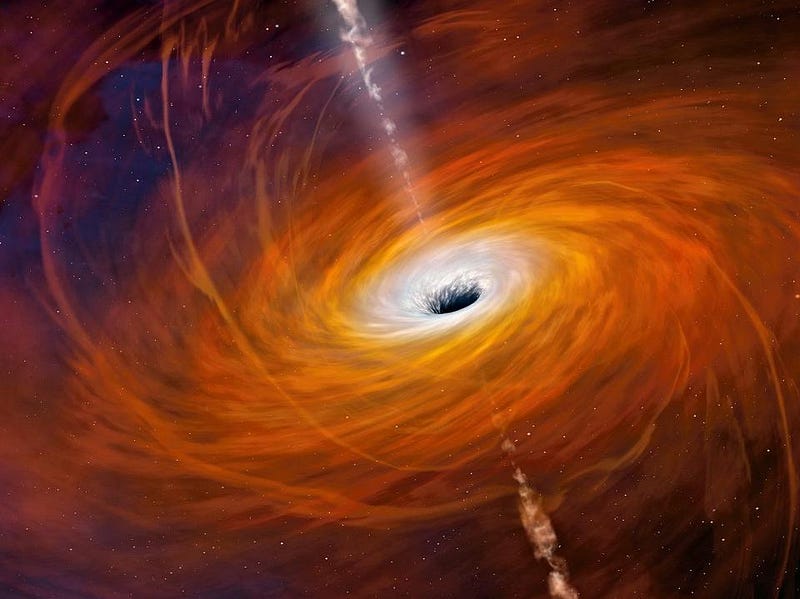
Radiation, although it covers the entire electromagnetic spectrum from low-energy radio waves all the way up to X-rays and gamma rays, is just the general term for all forms of light. So long as you have particles that exist outside of the black hole’s event horizon, they will create this form of radiation, and in the cases where relatively nearby black holes are feeding at fast enough rates, we’ll actually observe that characteristic X-ray radiation.
In fact, we can even look at the supermassive black holes from outside our own galaxy, and find those same features, only scaled up in both power and extent. The same physics is at play — charged object in motion create magnetic fields, and those fields accelerate particles along one particular axis — which is what creates the relativistic jets we observe from a distance. Those jets produce showers of both particles and radiation, and we can catch them even from Earth, sometimes even in visible light.
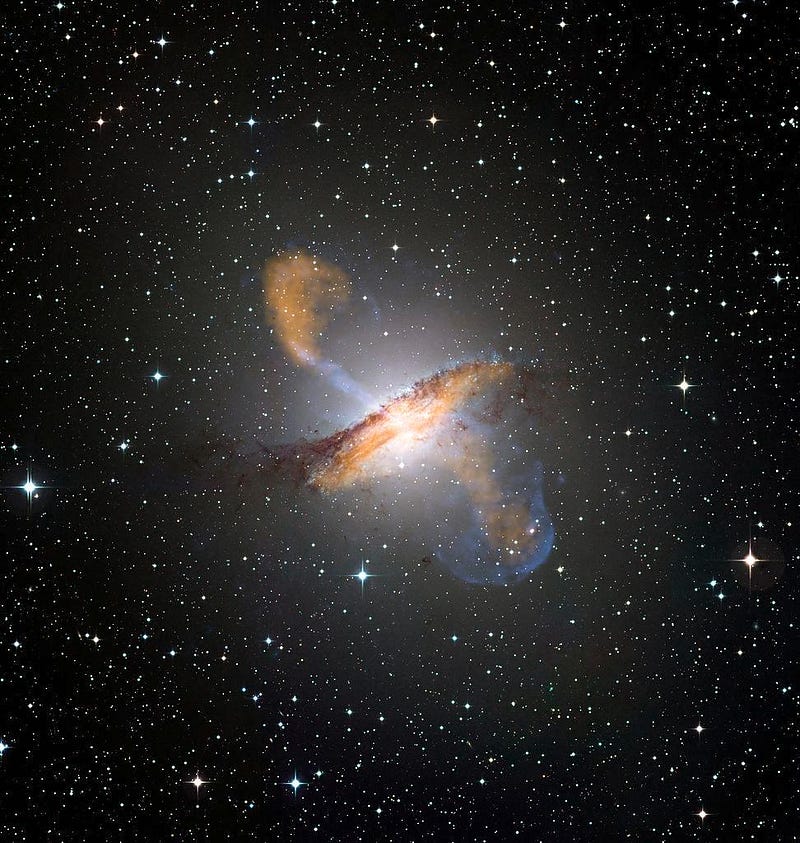
In some cases, where black holes are active and feeding, we can even observe a spectacular phenomenon known as a photon sphere. Around black holes, the fabric of space is so severely curved that it isn’t just particles that make circular-and-elliptical orbits around that central mass, but even photons: light itself.
The photon sphere is a little bit larger than the event horizon, and for realistic (rotating) black holes, the physics is more complicated than a simple, non-rotating case. However, the extreme curvature of space means that these photons will create a ring-like structure visible from any faraway perspective. The ring itself is larger than the event horizon, and the curvature of space makes the angular size of the ring appear even larger than that, but this is one of the things we need to calculate in order to understand why our first image of a black hole’s event horizon appears with the famous donut-like shape we observe.
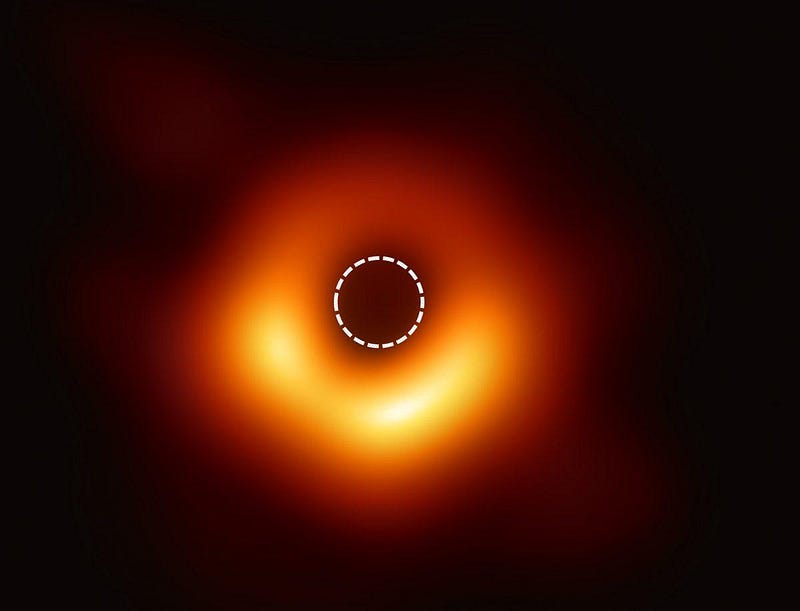
All of that, however, as interesting and light-emitting as it may be, only arises from material that hasn’t yet fallen through that critical region of space around the black hole: it’s all for things that remain outside the event horizon. Nothing can be seen arising from any material that actually goes inside the event horizon and winds up physically over that critical boundary.
However, if you could create a black hole that was completely isolated from everything else in the Universe — isolated from particles, radiation, neutrinos, dark matter, other sources of mass, etc. — all you’d have was the curved space resulting from the black hole’s presence itself. Unlike the static picture of curved space that you typically see, any particle at rest would feel as though the space it occupies is being dragged around and into the black hole; it’s as though the space beneath a particle’s proverbial “feet” is in motion, as though it’s fundamentally on a moving walkway.
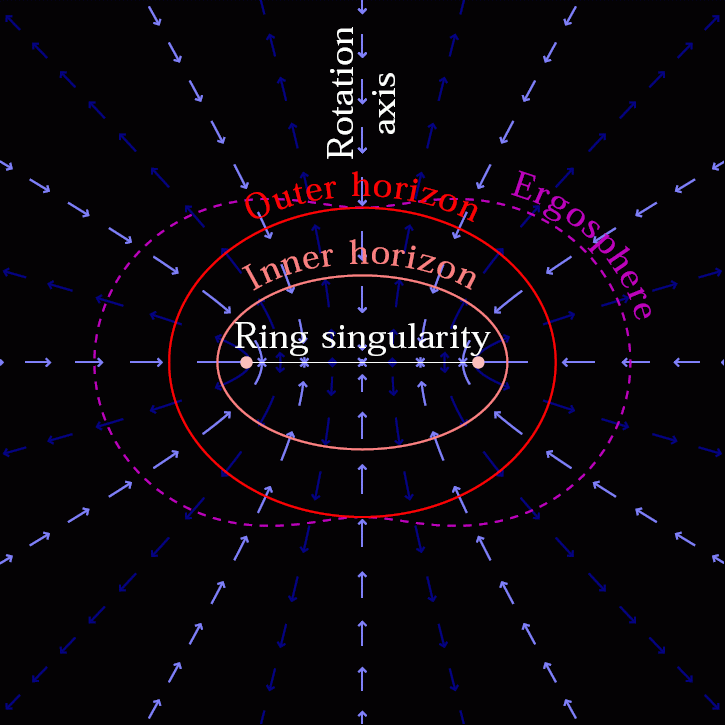
You’d have that curved space, an event horizon, and the laws of physics. And one of the things that the laws of physics teaches us is that the quantum fields that govern the Universe, even in the absence of any particles, are still present, constantly fluctuating as they inevitably must.
In flat space, this wouldn’t be a big deal. Energy fluctuations occur in the quantum vacuum, and in flat space, the quantum vacuum has equivalent properties everywhere. But when you have curved space — and in particular, space that’s more severely curved in one direction (towards the black hole) than the other (away from the black hole) — observers at different locations will disagree as to what the correct description of the lowest-energy state of the vacuum is.
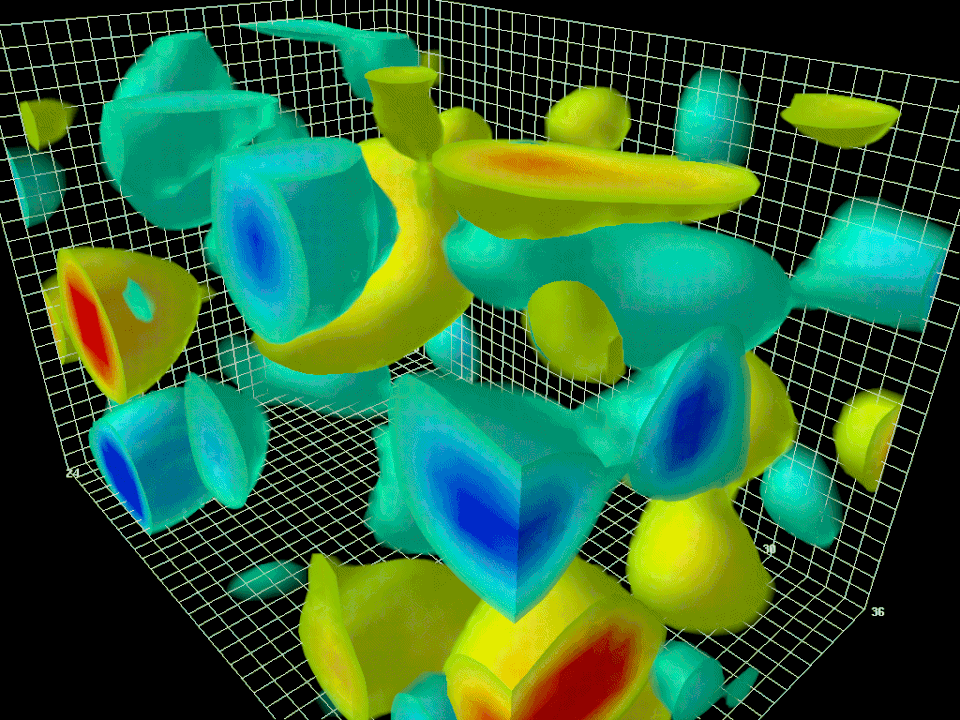
For someone far away from the event horizon, where space appears flat, they’ll observe some low-energy radiation coming from the more severely curved regions of space, even in the absence of any particles. This radiation carries real energy, and is a consequence of how quantum fields behave in curved space. The greater the curvature of space, the greater the rate that this radiation — known as Hawking radiation — gets emitted.
The energy for the radiation only has one possible source: it has to be stolen from the mass of the black hole. Fortunately, Einstein’s most famous equation, E = mc², describes this balance exactly. The smaller in mass the black hole is, the smaller the event horizon and the greater the curvature is near it. When you put this together, you wind up with a fascinating discovery: the less massive your black hole is, the more quickly it loses mass, emits Hawking radiation, and decays away.
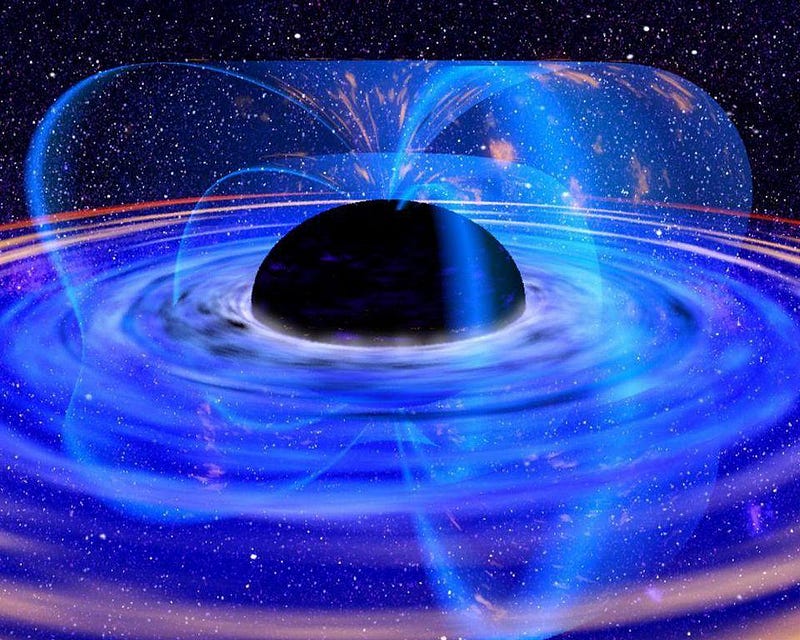
The rate at which an isolated black hole radiates its mass away, through Hawking radiation, is incredibly slow for any realistic black hole in our Universe. A black hole of our Sun’s mass would take 10⁶⁷ years to evaporate, while the one at the Milky Way’s center needs 10⁸⁷ years and the most massive ones known take up to 10¹⁰⁰ years!
Still, this is the only case where we can say that some form of energy from inside the black hole’s event horizon affects what we observe outside of it. The things that fall in through a black hole’s event horizon don’t come out again, not under any circumstances. The only things that a black hole can spit out come from outside the event horizon, from particles to conventional photons to even the Hawking radiation that get their energy from the black hole’s mass itself. There may be plenty of light that arises from black holes, but none of it can ever come from inside the event horizon.
Send in your Ask Ethan questions to startswithabang at gmail dot com!
Ethan Siegel is the author of Beyond the Galaxy and Treknology. You can pre-order his third book, currently in development: the Encyclopaedia Cosmologica.




